Related Research Articles

Leigh is a town in the Metropolitan Borough of Wigan, Greater Manchester, England, 7.7 miles (12 km) southeast of Wigan and 9.5 miles (15.3 km) west of Manchester, on low-lying land northwest of Chat Moss.
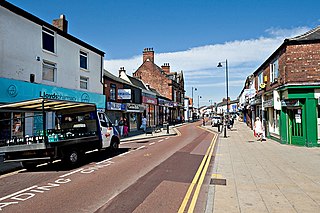
Atherton is a town in the Metropolitan Borough of Wigan, in Greater Manchester, England and historically was historically a part of Lancashire. The town, including Hindsford, Howe Bridge and Hag Fold, is 5 miles (8.0 km) east of Wigan, 2 miles (3.2 km) north of Leigh, and 10.7 miles (17.2 km) northwest of Manchester. From the 17th century, for about 300 years, Atherton was known as Chowbent, which was frequently shortened to Bent, the town's old nickname.

Astley is a village in the Metropolitan Borough of Wigan in Greater Manchester, England, which is crossed by the Bridgewater Canal and the A580 East Lancashire Road. Continuous with Tyldesley, it is equidistant from Wigan and Manchester, both 8.3 miles (13.4 km) away. The Astley Mosley Common ward had a population of 11,270 at the 2011 Census.
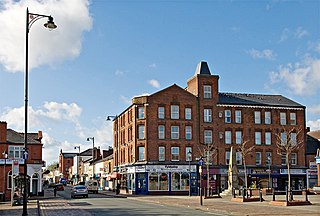
Tyldesley is a town in the Metropolitan Borough of Wigan in Greater Manchester, England, but historically in Lancashire. It is north of Chat Moss near the foothills of the West Pennine Moors, 7.7 miles (12.4 km) southeast of Wigan and 8.9 miles (14.3 km) northwest of Manchester. At the United Kingdom Census 2001, the Tyldesley built-up area, excluding Shakerley, had a population of 16,142.
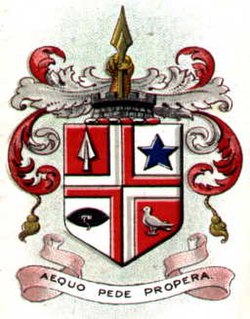
The Municipal Borough of Leigh was, from 1899 to 1974, a local government district of the administrative county of Lancashire, England, consisting of the townships of Pennington, Westleigh, Bedford and part of the township of Atherton and named after the ancient ecclesiastical parish. The area contained the market town of Leigh that served as its administrative centre until its dissolution in 1974. The borough council built Leigh Town Hall which was completed in 1907.
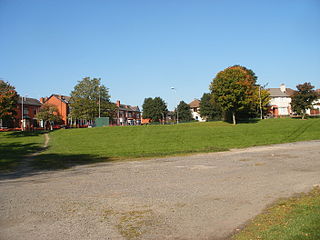
Shakerley is a suburb of Tyldesley in the Metropolitan Borough of Wigan, Greater Manchester, England. It was anciently a hamlet in the northwest of the township of Tyldesley cum Shakerley, in the ancient parish of Leigh. The boundary between Shakerley and Hindsford is the Hindsford Brook. It remains the boundary between Tyldesley and Atherton. Hyndforth Bridge across the brook, was rebuilt in stone in 1629.

Over Hulton is a suburb of Westhoughton within the Metropolitan Borough of Bolton, in Greater Manchester, England. Historically part of Lancashire, it lies 3.5 miles (5.6 km) south west of Bolton.

Tyldesley cum Shakerley Urban District and its successor Tyldesley Urban District was, from 1894 to 1974, a local government district in Lancashire, England.

Atherton was, from 1863 to 1974, a local government district in Lancashire, England.

Westleigh, a suburb of Leigh, Greater Manchester, England, is one of three ancient townships, Westleigh, Bedford and Pennington, that merged in 1875 to form the town of Leigh.

Atherton Hall was a country house and estate in Atherton historically a part of Lancashire, England. The hall was built between 1723 and 1742 and demolished in 1824. In 1894 this part of Atherton was incorporated into Leigh. Christopher Saxton's map shows there was a medieval deer park here in the time of Elizabeth I.
Kenyon is a village in the civil parish of Croft in Warrington, Cheshire, England.
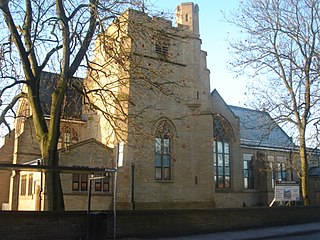
Hindsford is a suburb of Atherton in the Metropolitan Borough of Wigan, Greater Manchester, England. It is situated to the west of the Hindsford Brook, an ancient boundary between the townships of Atherton and Tyldesley cum Shakerley, and east of the Chanters Brook in the ancient parish of Leigh.

Bedford, a suburb of Leigh, Greater Manchester is one of three ancient townships, Bedford, Pennington and Westleigh, that merged in 1875 to form the town of Leigh. Historically, Bedford was in Lancashire.

Pennington, a suburb of Leigh, Greater Manchester is one of six townships in the ancient ecclesiastical parish of Leigh, that with Westleigh and Bedford merged to form the town of Leigh in 1875. The township of Pennington covered most of Leigh's town centre.
Fletcher, Burrows and Company was a coal mining company that owned collieries and cotton mills in Atherton, Greater Manchester, England. Gibfield, Howe Bridge and Chanters collieries exploited the coal mines (seams) of the middle coal measures in the Manchester Coalfield. The Fletchers built company housing at Hindsford and a model village at Howe Bridge which included pithead baths and a social club for its workers. The company became part of Manchester Collieries in 1929. The collieries were nationalised in 1947 becoming part of the National Coal Board.

Chorlton Poor Law Union was founded in January 1837 in response to the Poor Law Amendment Act 1834, also known as the New Poor Law. It was overseen by an elected board of 19 guardians representing the 12 parishes in the area it served: Ardwick, Burnage, Chorlton-upon-Medlock, Chorlton with Hardy, Didsbury, Gorton, Hulme, Levenshulme, Mosside, Rusholme, Stretford, and Withington, all in present day south Manchester, England.
James Burton was born in Clitheroe in 1784 and owned several cotton mills in Tyldesley and Hindsford in the middle of the 19th century.

Sacred Heart Church is a Grade II listed redundant Roman Catholic church on Tyldesley Road, Hindsford, Atherton in Greater Manchester, England. It has been designated by English Heritage as a Grade II listed building.
References
Notes
- 1 2 3 Wigan and Leigh Poor Law records, GenUKI, retrieved 2010-12-16
- ↑ Lunn 1971 , p. 162
- ↑ Lunn 1953 , p. 102
- ↑ Poor Law Unions 1837-1930, Lancashire Online Parish Clerks, retrieved 2010-12-16
- ↑ Leigh Workhouse, The Workhouse, retrieved 19 December 2010
- ↑ Leigh, Institutions.org, archived from the original on 2002-11-13, retrieved 2010-12-16
- ↑ Wilson 1976 , p. ?
Bibliography
- Lunn, John (1971), Atherton Lancashire, A manorial social and industrial history, Atherton UDC
- Lunn, John (1958), History of Leigh, Leigh Borough Council
- Lunn, John (1953), A history of Tyldesley, Tyldesley UDC
- Wilson, M.D. (1976), The Paupers of Leigh, Leigh Historical Society